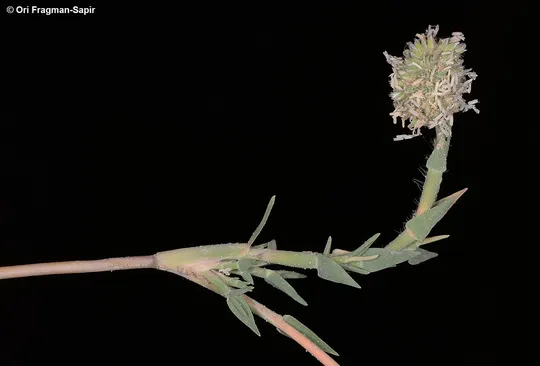Mangrove Grass, Rabbit-foot Aeluropus
Aeluropus lagopoides




Aeluropus lagopoides
is used in India and Pakistan as a pasture plant.
Aeluropus lagopoides
is found mainly along the Jordan Valley: in the Kinarot Valley and the Bet
She'an Valley, in the lower Jordan Valley, in the northern Dead Sea and in the
Central Arava. There are a few collections from the Samarian Desert (Wadi
Far'a) and from the northern Negev (Wadi Tsafit). The large
population that once was found in the Na'aman Salt Marsh in the Acre Valley has
declined greatly. Recently (2007) a population was discovered in the Zohar
Reservoir in the Philistian region (Oz Golan). This finding as updated in the
red table but not in the map. The number of site where A. lagopoides was
found in the 1980s and 1990s was greater than the number found in the 1920s and
1930s. This difference does not necessarily reflect an increase in the number
of sites but rather the more intensive search efforts in recent years.
Moist salt marshes
that are occasionally flooded and moist and salty edges of rivers and streams. Aeluropus
lagopoides usually grows in dryer and more saline habitats than A.
littoralis. It also
grows in the Sinai salt marshes, where it occurs in
clumps or scattered patches together with Nitraria retusa, Zygophyllum album
and Limonium axillare, often creating a monospecific zone behind the Halocnemum
strobilaceum zone.
The genus Aeluropus has five species, all halophytes
and all found in the Middle East. Only two species grow in
Europe, four in the Mediterranean Basin and one species whose distribution reaches
to India and northern China. A. lagopoides has a similar growth pattern and external morphology as A.
littoralis. However, the two species differ in several main characters: A.
lagopoides has spherical-ovoid short and dense inflorescences, and hirsute leaf
sheaths and spikelets; A. littoralis on the other hand has
elongated inflorescences, its spikelets are slightly apart and its leaf sheaths
and spikelets are glabrous. In Israel part of the ranges of both species overlap (Jordan Valley), but in general A.
lagopoides
is found mainly in the desert
and Jordan Valley salt marshes, while A.
littoralis also grows in the coastal salt marshes (hence its name) as
well as in the Jordan Valley salt marshes. According to the Flora Palaestina (1986),
there are hybrids between the two species in the Jordan Valley.
·
Many
Jordan Valley and Arava salt marshes are being converted into agricultural areas,
which reduce the amount of land suitable for halophytes, including Aeluropus
lagopoides. Pumping reduces the groundwater
levels in salt marshes drying the topsoil. As a plant dependent on the moist
and occasionally flooded soil, the habitat of A. lagopoides may disappear due to this activity.
·
A. lagopoides populations are fragmented according to the fragmentation pattern
of the salt marshes in which it grows. It sometimes appears in dense patches
due to vegetative expansion by rhizomes and stolons.
·
A. lagopoides is protected in the Ne’ot Hakikar Reserve (proposed reserve).
The species has a broad global
distribution and is not globally endangered.
Salt
marsh areas with high water levels in the Jordan Valley, in the Dead Sea area
and in the Aravah should be protected. The populations of both Aeluropus
species in the Wadi Malaha Reserve and their transition forms should be studied
and the populations should be monitored.
Aeluropus lagopoides
is widely distributed species, typical of salt marshes. Its distribution area includes
the southeastern European countries, Sicily, Cyprus, the Middle Eastern
countries, North Africa, Somalia, Ethiopia, Socotra Island, Pakistan, India and
Central Asia to China. In the Middle East, it is a common species, found in all
countries in the region.
Aeluropus
lagopoides is a perennial grass of moist salt marshes, adapted to special
conditions of a combination of salinity with
abundant water and periodic flooding. Changes in these ecological conditions
are the main threat to the continued survival of the species on its current
growth sites.
ויזל, י. ואגמי, מ. 1979. צמחי מלֵחה בישראל. הוצאת המדור לאקולוגיה.
Gulzar, S, and Khan, M.A. 2001. Seed Germination of a Halophytic Grass Aeluropus lagopoides. Annals of Botany 87: 319-324.
Current Occupancy Map
| 1000 squre meter pixel | 5000 squre meter pixel | 10000 squre meter pixel | |
|---|---|---|---|
| number of observations | 0 | 0 | 0 |
| in total pixels | 0 | 0 | 0 |
| Family | Gramineae |
| Classification | On the endangered species list |
| Ecosystem | Desert |
| Chorotype | Irano – Turanian – Saharo - Arabian |
| Conservation Site | En Rahel North of the Sapir Center (HaTsinim Cliffs Nature Reserve) |
| Rarity |
1
2
6
|
|---|---|
| Vulnerability |
0
4
4
|
| Attractiveness |
0
0
4
|
| Endemism |
0
0
4
|
| Red number |
1
3.2
10
|
| Peripherality | 0 |
| IUCN category | DD EW EX LC CR EN VU NT |
| Threat Definition according to the red book | Vulnerable |
 Based on:
Based on:






